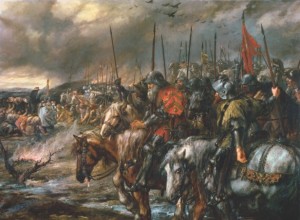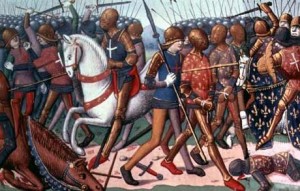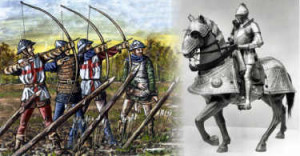Battle of Agincourt Facts
The Battle of Agincourt is one of Europe’s most famous battles, echoing down the centuries in historical record, song and even dramatic re-enactment on stage and film. The battle itself was part of the Hundred Years War, a series of conflicts that actually waged for over a century (1337-1453) between the Kingdoms of England and France for control of the French throne.
The two contenders for the throne were the House of Valois, a noble French family from the Capetian dynasty that had claimed the throne under Salic Law, and the House of Plantagenet’s Angevin family, who contested the claim due to the ancestral marriage of Edward II of England to Isabella of France. These contested claims led to a number of brutal battles throughout the 14th and 15th centuries, which came to a head in the Battle of Agincourt, a horrific battle fought between King Henry V and King Charles VI on 25 October 1415.
The battle itself was a major English victory against a numerically superior French army that rested on a series of tactical mistakes by the French, commanded by Constable Charles d’Albret, and a series of tactical masterstrokes by King Henry V. Indeed, Agincourt has gone down in French history as one of their most disastrous defeats, with around 8,000 French troops killed and hundreds of others wounded or taken prisoner. In contrast, the English losses were in the low hundreds.
 Interestingly, however, despite the conflict being such an obvious and celebrated English victory, the battle is remembered today more for its vivid representation of the polarized views and consequences that war in general generates. There are a number of reasons why opinions about it are so divided.
Interestingly, however, despite the conflict being such an obvious and celebrated English victory, the battle is remembered today more for its vivid representation of the polarized views and consequences that war in general generates. There are a number of reasons why opinions about it are so divided.
The first is due to the sheer magnitude of the casualties and the way in which they died. Records indicate men were decapitated, cleaved in two, had their bones shattered, were trampled to death, suffocated and had their major organs shredded by arrows. The battle was, without doubt, one of the bloodiest meat-grinders ever witnessed.
The second, and arguably more poignant reason, is despite Henry winning the day at Agincourt and later being named regent and heir to the French throne – a goal he had chased all his adult life – he died before he could be crowned and his successors proceeded to quickly lose both the throne and much of the territory in mainland France that he had won through his campaign.
 Lastly, despite Henry’s actions being accepted as justified at the time by both French and English chroniclers, his actions were heavily criticized both morally and ethically in later times. Arguments not only contested his right to invade, but also his decision to execute all but a handful of the French prisoners taken at the battle, which while numbers are unclear, probably approached, or even exceeded, a thousand men. Indeed, the French losses at Agincourt largely obliterated their aristocracy, with hundreds of noblemen (including three dukes, eight counts and one viscount], knights and even an archbishop killed in the fighting.
Lastly, despite Henry’s actions being accepted as justified at the time by both French and English chroniclers, his actions were heavily criticized both morally and ethically in later times. Arguments not only contested his right to invade, but also his decision to execute all but a handful of the French prisoners taken at the battle, which while numbers are unclear, probably approached, or even exceeded, a thousand men. Indeed, the French losses at Agincourt largely obliterated their aristocracy, with hundreds of noblemen (including three dukes, eight counts and one viscount], knights and even an archbishop killed in the fighting.
In this article We breaks down the main events of the battle itself, analyses the surrounding context, highlights the key players and explores the ramifications that Agincourt had on the economic, social and political spheres of Europe in the Late Middle Ages and beyond.
Step-by-step event guide
 1. Henry advances towards the French frontline, ordering his archers to uproot their defensive spear wall and replace it farther up the battlefield. This catches the French forces off-guard and they fail to charge before the spear wall is reinstated. English longbowmen in the central frontline begin bombarding the French with arrows.
1. Henry advances towards the French frontline, ordering his archers to uproot their defensive spear wall and replace it farther up the battlefield. This catches the French forces off-guard and they fail to charge before the spear wall is reinstated. English longbowmen in the central frontline begin bombarding the French with arrows.
2. While the French frontline try to quickly organise themselves for a frontal charge, Henry orders his flanking squads of longbowmen to move up the battlefield within the trees to the right and left, advancing to a point where they can fire from either flank into the centre of the French troops. Like the frontline archers, they set up spear walls.
3. Constable D’Albret orders the French frontline to charge at the English frontline. They are met by multiple waves of arrows, which decimate large numbers of their cavalry and infantry as they cover the central battlefield, f The English archers on each flank also begin firing, hitting the French frontline from both sides.
4. D’Albret and limited numbers of the French frontline reach the English spear wall and begin to engage them in hand-to-hand combat, pushing it backwards. The longbowmen retreat and Henry orders his infantry to advance and meet the French.
5. Fierce, close-quarters fighting begins upon the sodden, muddy ploughed terrain at the centre of the battlefield. The combination of the dense mud and heavy armour worn by the French knights leads to thousands of them getting severely bogged down and exhausted, with the lighter-armoured English forces able to operate much more effectively.
6. D’Albret is suddenly killed in the melee, falling into the mud. Meanwhile, the French second line advances into the centre of the battlefield congesting it further.
7. The Duke of York is killed by a blow to the body and proceeds to get lost amid the sea of fighting soldiers. In addition, Henry’s brother – Humphrey, the Duke of Gloucester – is wounded by a blow to the groin. Henry quickly moves to his position and defends him with his personal retinue – he succeeds but in the process receives a blow to the head that removes part of his crown.
8. The Duke of Bar is killed as his forces get depleted by the encircling English. Upon seeing the disaster that is unfolding before his eyes, the Duke of Alenon attempts to reach the English to submit a surrender notice, however he is killed by a blow to the head before it can be delivered.
9. The third line of French forces hovers on the outskirts of the battle, unsure whether to fight or not. Henry perceives they will and, due to the large number of unrestrained French prisoners from the first and second waves, orders all but the most high-ranking to be executed to prevent them from rearming en masse and overrunning the exhausted English.
10. Upon seeing the vast losses and executions, the French third line, led by the Counts Fauconberg and Dammartin, retreat to the rear, fleeing the battlefield. Henry wins the battle and orders a count of the dead, which reveals roughly 8,000 French troops had died compared to the English’s 450. point the two side flanks of English archers abandon their ranged weapons and rush into the French second line from both the right and left.
